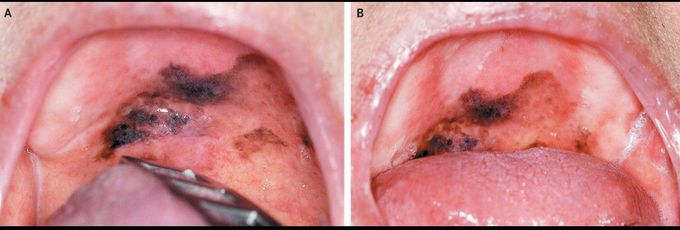


Melanoma of the Oral Cavity
A 75-year-old white man presented with a 3-week history of nonpainful discoloration of his palate. The lesion had developed spontaneously beneath his dentures and expanded toward the mucosa of the soft palate. He reported having no history of nicotine or alcohol use. On physical examination, slightly elevated, bluish-brown lesions with irregular boundaries were noted on the palate mucosa, without induration. Histopathological examination revealed an infiltrating lentiginous melanoma. Oral mucosal melanoma is a rare neoplasm. Primary melanoma of the oral cavity accounts for 0.5% of all oral cancers, and 0.8 to 1.8% of all melanomas occur at mucosal sites. The prognosis for melanoma of the oral cavity is poor, with a reported 5-year survival rate of 12.3%. The patient was referred to a tertiary care oncology center for additional diagnostic workup and therapy. No pathological lymph nodes were found. He underwent partial maxillectomy but declined adjuvant radiotherapy. At follow-up 6 months after surgery, there were no signs of tumor recurrence.
Why is the 5-year survival rate so low? Does that still hold true despite the removal and no tumor recurrence?

